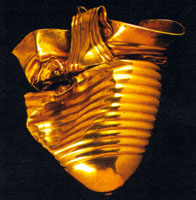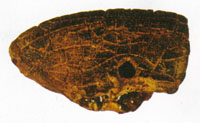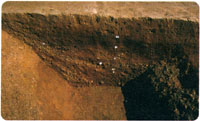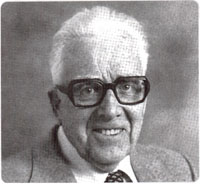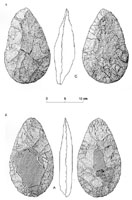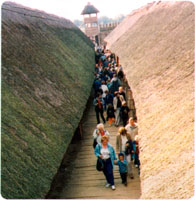| Ringlemere:
The Nature of the Gold Cup Monument |
When an incredibly rare Early Bronze Age gold cup was unearthed by Cliff Bradshaw on a very slight eminence in an arable field at Ringlemere, east Kent, it was easy to jump to conclusions. The idea that the discovery had led us to a long-since denuded and consequently unrecorded barrow was quickly supported by the results of geophysical survey by English Heritage which revealed an annular feature - apparently the ditch encircling a barrow. Inspection of extant aerial photographs by Simon Mason of the Heritage Conservation Group, Kent County Council, moreover, showed that this monument was not isolated; at least three further ring-ditches were in evidence. When account was also taken of the grave contexts of the one British parallel in gold, from Rillaton, Cornwall, and some of those in other precious materials (amber, silver, shale), it could surely be deduced that the Ringlemere cup had been a funerary accompaniment, dislodged from its grave by recent ploughing. To cap it all, two finds of amber - a half of a pommel and a probable pendant fragment - both unfortunately from disturbed contexts, would be wholly in place in a ‘rich’ Early Bronze Age grave group. That the cup had been caught by modern agricultural machinery, perhaps in the course of periodic subsoiling, is still the most likely explanation for much of its damage. It was located at a depth of 0.42m, around the base of the modern plough soil, and the relocated findspot, once excavated, was found to be met by a deep plough furrow. There was no reason to question the likelihood that it had been hoicked out of a progressively truncated burial deposit. However, as excavations have proceeded over the ensuing two years, understanding of the character of the site has changed and has not lent any support to this straightforward interpretation. Excavation of the barrow ditch has now confirmed that it enclosed an area with a diameter of 42 metres. This was clearly a large barrow. Our first trench, funded by English Heritage, showed the ditch also to be of substantial proportions, 4.60m wide and 1.40m deep, with a flat bottom. A remnant of an original mound was indeed found inside, surviving to a maximum height of 0.50m in the middle. Careful excavation of this remnant mound, however, yielded a surprising assemblage: considerable quantities of Late Neolithic pottery and flintwork, the former almost universally of Grooved Ware, with a few sherds of Beaker. Clearly, there was noteworthy activity on or close to the site some centuries before the cup was deposited, circa 1700 - 1500 BC. Not only was this material within the core of the mound, comprising a turf-stack, but more came from the buried soil beneath. Three subsequent excavations, two funded by the British Museum, one by the BBC, have only gone to reinforce this pattern to the point that just under 40% of the interior of the ring-ditch has already yielded 3500 sherds of pottery. There are also cut features associated with the old land surface, mostly shallow pits. Some contained impressively large sherds of Grooved Ware and one has yielded a date of 2890-2600 Cal BC (2 sigma; Beta 183862) on contained charcoal. Despite this welter of Late Neolithic remains, not a single further artefact of full Early Bronze Age date (excluding a barbed and tanged arrowhead which could be earlier) has been recovered so far. Unburnt bone barely survives on the site, but grave-like features have been similarly elusive as have any cremation deposits, apart from a few scattered fragments of burnt ?human bone. By September 2003, when the fourth trench was underway, any former simplistic assumptions on the nature and history of the site were increasingly coming under question. As fate would have it, the stretch of ditch within this trench proved to have a terminal - there was an entrance facing north! The geophysics plots were too fuzzy to show this or any possible opposing entrance, but the possibility that this site originated as a henge monument, constructed during the third millennium BC at the time of Grooved Ware use, suddenly became considerably enhanced. Although the evidence is slight, some of the excavated ditch fills suggest that more material was slipping in from the outside than the inside, suggestive of an external bank appropriate to a henge monument.
If the new excavated evidence makes more sense of the diameter and dimensions of the ditch as well as of the vast predominance of Late Neolithic finds, it still leaves intriguing questions to be asked of further seasons of excavation. Firstly, when was the internal mound constructed (the incorporated Grooved Ware might already have been old at the time) and what dimensions might it originally have had? Any assumption that it was large may be mistaken, especially if most/all of the ditch spoil had gone to form an external bank. In fact, another surprise discovery of the last season, a sunken floored hut of the early Saxon period dug into the outer edge of the mound, suggests that while advantage may have been taken of a still visible enclosure, the mound was already at that time a relatively low feature. Perhaps it was never substantial. Secondly, what was the original context of the three fine Early Bronze Age objects if they were introduced to an already ancient site? We still cannot rule out the insertion of a ‘rich’ burial at a late stage of the period during which the site remained a focal point. The ring ditches nearby, now increased to a minimum of seven by survey work by Aaron Birchenough of Bournemouth University, are more modest in diameter and much more like a conventional barrow group; it would be surprising if no interments had been made in this monument complex during the Early Bronze Age. The search for possible grave contexts will continue in 2004, but valuables in gold and other materials were not exclusively placed with the dead at funerary sites, as is clear from, among other finds, the gold armlets excavated as part of a small hoard on the edge of a mound at Lockington, Leicestershire, and the amber cup paralleling the Ringlemere cup from within the body of the mound of Clandon barrow, Dorset. If burial evidence is not ultimately forthcoming, then other exciting interpretations will need to be explored to account for the presence of the cup on an earlier ceremonial site. Keith Parfitt & Stuart Needham
|
| THE BARRYSBROOK
BOWSTAVE |
| NORTH-EAST RESEARCH
FRAMEWORK FOR THE HISTORIC ENVIRONMENT |
| The latest of the English Heritage-funded regional research frameworks has recently got underway. Based in Durham, the North-East Regional Research Framework for the Historic Environment aims to create a commonly agreed research agenda for those studying the archaeology and historic environment of the north-east. This agenda will help local archaeology curators and conservation officers to justify their curatorial decisions, allow regional and national funding bodies to direct their grants to where they are most needed and direct researchers of all backgrounds to the most pressing topics in the study of the region’s archaeological and architectural history. It also hopes to bring together all those involved in the study of the historic environment, whether local government curators, commercial contractors, academics or those working in the amateur sector to try to increase links and encourage the growth of a positive research community in the region. To help with this project, a series of period overviews will be written, outlining the existing resources (archives, museum collections, etc) and noting the gaps in our knowledge. A series of specialist period groups will advise the project officer in the writing of these overviews and help to define the paths for further research. We are keen to hear from all those who are researching the prehistoric archaeology of the north-east region (defined as Northumberland, Tyne and Wear, County Durham and Cleveland), particularly those based outside the region. If you would like to have an opportunity to comment on the work of the project and contribute towards the creation of a research agenda which will set the tone for the archaeological investigation of the prehistoric north-east of England please contact the Project Officer, Dr David Petts on 0191-383 4225 or david.petts@durham.gov.uk
|
| CONFERENCE
NEWS |
||
| This three day international conference is dedicated to the intellectual, historical and methodological crossovers between sculpture and archaeology from prehistory to the present. It looks at the myths and metaphors of archaeology and their sculptural currency, the archaeological and sculptural status of the fragment, at the philosophy of place and questions of site-specificity, at the political appropriation of archaeology by sculptors and writers, and at the notion of the artist as archaeologist. It brings together archaeologists, art historians and sculptors and is chaired by Dana Arnold (Southampton University), Barbara Bender (UCL), Thomas Dowson and Julian Thomas (Manchester University), Anne Wagner (Berkeley, USA) and Jon Wood (Henry Moore Institute). Attendance £30 (£15 concessions). Contact Liz Aston
|
| TWO
RECENT MEETINGS ON ROCK ART As Michael Rainsbury reports, a workshop on recording rock art (Edinburgh, 7 March 2003) and a conference ‘New Developments in British Rock Art’ (Durham, 8th March 2003) testify to increasing interest in this rich area of research. |
| British rock art was the subject of a workshop and a conference early in March of last year. The Workshop on Recording Rock Art was organised by Sally Foster (Historic Scotland) together with Margarita Díaz- Andreu (University of Durham). It was held at Longmore House, Historic Scotland’s headquarters in Edinburgh. Twenty-seven participants assembled to swap ideas and techniques relevant to rock art research. The morning session was given over to presentations, with an afternoon of practical work. Four presentations commenced with a brief introduction by the organisers, followed by the Danish rock art specialist Gerhard Milstreu talking about the Scandinavian experience of documentation and care of rock art. Jack Stevenson (RCAHMS) continued with an interesting paper about recording rock art in Scotland. Jan Magnusson, the project manager of RANE (Rock Art in Northern Europe), explained about the development of documentation standards and IT systems. The final presentation showed experimentation undertaken at the University of Durham on digital image processing and recording rock art carvings by Andrew Blanshard and Michael Rainsbury. The afternoon session consisted of group work where rubbing techniques, digital image processing and laser scanning technology (courtesy of Archaeoptics) were demonstrated to the participants. The conference, ‘New Developments in British Rock Art’, was held in the Department of Archaeology at the University of Durham with the support of the Prehistoric Society. Organised by Margarita Díaz- Andreu with Kate Sharp, Andrew Blanshard and Philip Deakin, more than 140 delegates were brought together to hear seven speakers debate the current state of knowledge on British rock art. After the official welcome and an introduction to the current debate by Margarita Díaz-Andreu, Richard Bradley spoke about the placing of British rock art in the landscape, arguing that the presence of rock art on outcrops, as well as inside and outside passage tombs and cist burials, indicates that the carvings were placed with a view to different audiences. Stan Beckensall followed next regaling the audience with gory details from the North of England’s history before he discussed his current work in Ireland. Clive Waddington then lectured on the two different art traditions of passage grave art and cup-and-ring marks. He compared and contrasted the two traditions discussing stylistic comparisons, distribution, context, and the reuse and aesthetics of the art. He maintained that the cup-and-ring tradition predates passage grave art and may date back to 4000 BC. Kate Wilson of English Heritage discussed rock art management, assessment, study and education strategies for England, covering the Rock Art Pilot Project and its future. The last speaker was Sally Foster of Historic Scotland on ‘Shaping up rock art in Scotland: past progress and future directions’. The conference finished with final words from Durham anthropologist Robert Layton on the problems of understanding ancient people’s readings of the landscape. Of the new developments in British rock art, perhaps the most noticeable is the increasing interest the subject arouses, with more than one speaker commenting on this. A general view was that a conference dedicated to British rock art would not have been possible ten years ago due to lack of interest. British rock art research is now an established discipline with a strong future. Michael Rainsbury
|
| NOTICE
OF THE ANNUAL GENERAL MEETING |
||||||||||||||||||
| The AGM will be held at 4.30 p.m. on Wednesday
19th May, 2004, in the rooms of the Society of Antiquaries of London,
Burlington House, Piccadilly, London.
The meeting will be followed at 5.00 p.m. by the 13th
Europa Lecture by Professor Leendert Louwe Kooijmans (Emeritus Professor,
University of Leiden) on ‘The Adoption of Agriculture in North-West
Europe: The View from the Dutch Delta’. The lecture will be followed
by a wine reception.
Notes:
|
||||||||||||||||||
| Prehistoric Society events over the past year have been held across most of Britain in venues stretching from Glasgow to Exeter and from Cardiff to Norwich. Some of these have already been reported on in the pages of PAST; watch out for further reviews in future editions. In May, the 12th Europa lecture was given by Professor Seamus Caulfield on ‘Structured Space and Place: the Neolithic of Western Europe’ and there was a research weekend on barrows at Dillington. Thanks to Wayne Benett for organising the latter. The UK study tour to Northumberland in July was very enjoyable and the Society extends its thanks to Rob Young, Peter Forester and their associates at the Northumberland National Park for all their help organising the trip. We are also grateful to Paul Frodsham, Al Oswald, Phil Deakin and Stan Beckensall for helping to bring the prehistory of this beautiful area to life. The Andante Tour to Poland took place in September and is reported on in this newsletter. Andante must be thanked for organising this tour so effectively and thanks are also extended to the tour leader Professor Anthony Harding and to the Council’s representative for the trip, Julie Gardiner. In October, the Third Sara Champion Memorial Lecture was given by Rachel Pope of Durham University on the subject of ‘Social Change in Later Prehistory: Evidence from the Northern Roundhouse’ and saw our first powerpoint presentation in the Society of Antiquaries - an event that passed without trouble. Over in Norfolk, David McOmish spoke on ‘Cursus Enclosures - Solving a 6000 year old puzzle’ to a joint meeting of the Prehistoric Society and Norfolk and Norwich Archaeological Society. A joint meeting with the Society of Antiquaries of Scotland took place in Edinburgh in December and saw Anne Woodward talking on ‘Ritual and Relics in Early Bronze Age Britain’. Three meetings were held in January. In Exeter, Professor Leedendert P. Louwe Kooijmans talked on ‘The Hardinxveld excavations: a Dutch Paradise for Mesolithic archaeology’ whilst in Cardiff, a research day on ‘Monumentality in the Late Neolithic and Early Bronze Age’ was well attended. Thanks to Esmée Sykes for organising the former and Vicki Cummings and Chris Fowler for the latter. The British Museum hosted a Treasure Research Day to coincide with their exhibition ‘Treasure: Finding our Past’. Lectures in the morning were given by Stuart Needham, JD Hill, Adam Gwilt and Natasha Hutcheson, after which members were free to look around the exhibition. Talks were to resume later in the afternoon, but were cut short by a fire alarm and eventually the meeting was disappointingly closed early. Thanks go to JD Hill for setting up this event. At the time of writing, the Society’s next event is a joint meeting with the Glasgow Archaeological Society where Clive Ruggles, Professor of Archaeoastronomy, will be speaking on ‘Ulster’s Bronze Age monuments - links with the cosmos’, a well-timed topic considering the Society’s UK study tour to Northern Ireland in July. There are no places left on this year’s tour, but plans are being formed for next year’s proposed UK study tour to South Wales and our overseas study tour to Croatia. Also coming up soon is a research day in Sheffield, a moors research weekend at Dillington House and the 13th Europa lecture. In October, we are holding a joint conference with the Prehistoric Ceramics Research Group in Bradford, whilst in November we explore the modelling of the Palaeolithic and Mesolithic in Southampton - please see the programme listings for details. Finally, the Society would like to thank all those institutions and individuals who work so tirelessly to put on Society meetings. The regional profile of the Prehistoric Society is one of its strengths and without the input of many dedicated people this would not be possible.
|
|
| The figures reveal that the downward trend in membership appears to be stabilizing. The presence of the website has widened the membership base and preliminary figures for 2004 suggest that the website is leading to increased membership. A membership and recruitment drive is planned for 2004, which should enhance membership numbers.
|
||||||||||||||||||||||||||||||||||||||||||||||||||||||||
| John & Bryony Coles Award Research Grants
|
|
| SUMMARY
OF FINANCIAL ACTIVITIES FOR THE YEAR ENDED 31 DECEMBER 2003 |
||||||||||||||||||||||||||||||||||||||||||||||||||||||||||||||||||||||||
The Summary of Financial Activities is an extract from the full accounts of the Society. Copies of the full accounts for 2003 can be obtained from Tessa Machling at the registered office address and they will be available for members attending the Annual General Meeting. The 2003 annual accounts will be sent to the Registrar of Companies after the Annual General Meeting. Report of the Treasurer The Council has continued to reduce the administration cost of the Society. The policy of the Council is that any sustainable surplus will be used to increase the funding allocated for education and the promotion of prehistory.
|
||||||||||||||||||||||||||||||||||||||||||||||||||||||||||||||||||||||||
| Madge Langdon suffered a heart attack in July 2002 and died on 2nd February 2004 at the age of 84. She joined the Society in 1956 and thereafter was a regular attender, with her husband Charlie, at Spring Conferences and Study Tours. As well as being an active local archaeologist in her home town of Highbridge, Somerset, from 1972 she also took on the honorary duties of Assistant Treasurer. This involved her helping successive Treasurers with members’ deeds of covenant (and also serving as a ‘lightning conductor’ on issues which sporadically cropped up amongst our non-academic members), a role which she continued to perform for a splendid twenty-five years. In recognition of this sustained period of service, Madge was created an Honorary Member of the Society in 1993. Over 150 mourners attended her funeral. We will miss her steady, lowprofile support for our activities and we offer our condolences to her husband at this difficult time. John Cruse
|
|
|
THE SHOTTON PROJECT: A MIDLANDS PALAEOLITHIC
NETWORK |
||||||
| The provision of a new source of funding within the archaeological community has provided the opportunity to forge new paths in Palaeolithic archaeological research. Early in 2002, funding was made available to English Heritage, English Nature and the Countryside Agency through the Aggregates Levy Sustainability Fund. The Levy is provided by the Aggregates Industry to help tackle a wide range of problems in areas affected by the extraction of sand and gravel deposits (aggregates) from quarries. Palaeolithic archaeology can perhaps claim to be the period most affected by gravel extraction, as the majority of Palaeolithic artefacts are found in sand and gravel quarries, generally within deposits dating anywhere up to (or beyond) 500,000 years ago.
The Shotton Project received funding from English Heritage in March 2003 for a year, with the idea of promoting the Palaeolithic in the Midlands to all by raising its profile on public, curatorial and academic levels, both within and outside archaeological circles. The project is named after Professor Fred Shotton, a geologist, natural historian and Fellow of the Royal Society. He was a Coventry man who spent many years of his life researching the geology of the West Midlands, culminating in his Professorship at the University of Birmingham between 1949 and 1974. Retirement was no barrier for Professor Shotton, and he continued his research until he died in 1990 aged 83. Shotton’s tireless work throughout the twentieth century has added much to our understanding of Midlands geology, palaeontology and archaeology. He pioneered the multi-disciplinary approach of studying Palaeolithic finds in their full geological and environmental context. Shotton also developed a network of ‘eyes’ in the field - local geologists, archaeologists and quarry workmen who would notify him of anything they thought important, including bones, fossiliferous deposits and handaxes. The culmination of Shotton’s career was the discovery of organic channels below the sand and gravel at Waverley Wood Farm Pit in Warwickshire (Wise 1993). The site is now internationally recognised, due to its position along an ancient river system known as the ‘Bytham River’, which was obliterated by glacial ice about 480,000 years ago, but was once a major corridor for the human settlement of Britain. Among the finds were three handaxes made of andesitic tuff (Shotton & Wymer 1989). The evidence from the deposits at Waverley Wood showed that hominids shared the local environment with straight-tusked elephant, deer, bison and horse in a landscape of coniferous forest and grassy meadows.
Since the death of Professor Shotton, Palaeolithic studies have not advanced much in the West Midlands and the network of enthusiasts has to a considerable extent dried up. The main aim of the Shotton Project is to re-ignite this network by raising the profile of the Palaeolithic in the Midlands region, and by carrying out systematic evaluation and monitoring of sand and gravel quarries for Palaeolithic finds and deposits. Moreover, there is a need to ensure that Palaeolithic archaeology is afforded the same resources as the archaeology of later periods during sand and gravel quarrying. The Project is attempting to follow the lead of Leicestershire, which has placed planning conditions on deep excavation in quarries; these conditions cover any archaeological material found within such deposits. Meetings have been held with curatorial archaeologists - those working within local government - to encourage better provision for the discovery and investigation of Palaeolithic sites. However, the Palaeolithic is not just about the archaeological material found in quarries. The evidence from Waverley Wood was not only archaeological, as bones from mammals, pollen, snails and beetles were also recovered from the organic channels. Palaeolithic archaeology must be seen as just a small part of the wider environmental picture. These remains often provide dating evidence and give us a better and wider outlook on the changing environments of the past. So, how does one approach creating a network of individuals interested in the Palaeolithic of the Midlands? Contacting people in as many different ways as possible has been one of our key objectives. These have included leaflets, newspaper articles, displays, talks to local archaeological societies and presentations at county archaeology days and symposia. Training days which include artefact recognition and talks from specialists have also been organised. Artefact recognition is particularly important, and is one of the aspects we are trying to introduce so that the network and knowledge continues after the funding ends. We are designing artefact recognition sheets that people can take out with them when fieldwalking. The sheets give an introduction to different types of Palaeolithic tools, the materials used and the identification markers to look for on flint and quartzite artefacts. Eventually this will become part of a larger ‘handbook’ that will give the reader a background in British geology, Palaeolithic archaeology and palaeontology as well as providing guidance for fieldwork. It is hoped that by generating interest in the Palaeolithic and Pleistocene and getting people out into the field, the chances of finding archaeological and palaeontological material will be greatly increased. The Shotton Project has been funded for a year, but it is hoped that with the right procedures in place, the network will continue long beyond the life of the project. From the inquiries received, we can build a database of interested parties including specialists in this field of research as well as volunteers who would like to learn more about the Palaeolithic. The project is not exclusive in any way and it is hoped that with enough interest members will get the opportunity to add to the Midlands database of Palaeolithic and palaeontological finds. Alex Lang
References
|
||||||
|
INTRODUCING ‘PAMELA’:
THE UPPER PALAEOLITHIC & MESOLITHIC DATABASE FOR ENGLAND |
|
| Anyone who has ever done any research into the Upper Palaeolithic or Mesolithic of England will be aware of the vast archive of information that has been compiled by Roger Jacobi over more years than we are sure he would care to remember. Roger’s spare bedroom is full of boxes of index cards, and shelves and filing cabinets of notes, offprints and superb flint illustrations. Most museums and at least the major private collections have been visited at least once and catalogued personally. So encyclopaedic is Roger’s memory that we are sure he remembers virtually every piece of flint individually! It is 25 years since the publication of the Gazetteer of Mesolithic (and upper Palaeolithic) Finds in England and Wales, edited by John Wymer. This fact, coupled with Roger’s need to reclaim his spare room, led to the setting up of a steering committee, consisting of Andrew Lawson, Clive Gamble, Jill Cook and Paul Mellars, to consider ways of securing the Jacobi Archive for posterity and making it easily accessible for anyone to consult. A research design for the creation of a nationally available online database (nicknamed PaMela) was prepared by Julie Gardiner and John Lewis of Wessex Archaeology, and English Heritage agreed to fund three phases of a four phase programme. The project is being undertaken by Wessex Archaeology in collaboration with Roger Jacobi, and is managed by Julie Gardiner with guidance from the steering committee. Put simply, the three phases consist of:
The fourth phase – a full survey of the Mesolithic resources of the rest of England – will require additional funding, hopefully from several sources. It is intended that the fully searchable database, linked to a GIS, will be available online with a security copy of the original archive lodged with the Archaeological Data Service in York. The archive is first scanned and burned onto CD and the data from the scanned record is entered into the database. Supporting information (such as illustrations and detailed descriptions) are linked to the database records as image files. There have, inevitably, been some teething problems, mainly in establishing the optimum resolution and file format for storing the images, but the database structure has been established and the long blade assemblages for the whole country, and Mesolithic archive for one county, have been input as a pilot study. The project should be completed in the coming 18 months or so. The information will not, however, be accessible until the project has been completed to the end of Phase 3 (and dissemination methods are agreed with English Heritage) and, in the interim, any requests for access to the original information should, as previously, be addressed to Roger, whose property it remains. Julie Gardiner and Chris Brayne,
|
|
|
THE INVESTIGATION OF A POSSIBLE CUCUTENI
SALT-PRODUCTION SITE IN ROMANIA, SUMMER 2003 |
|
| Last summer, John Chapman continued the Durham-Iasi partnership with Dan Monah in the excavation of the small Late Cucuteni site of Prohozesti-Siliste, midway between the only tell known in the Cucuteni culture (tell Poduri) and a rich salt spring. The main problem for investigation was the likelihood that Prohozesti was used partly as a seasonal site for brine evaporation, a strategy ultimately controlled by the tell-living community. A two-week excavation season was mounted, during which two trenches were opened up to investigate the hearth-sized magnetic anomalies discovered during the 1999 geophysical prospection. The project was supported by a research grant from the Prehistoric Society. The presence of short-term features (pits, post-holes, stake-holes and temporary surfaces) and the absence of long-term structures (developed cultural layers, permanent structures and heating features), as well as any signs of structured deposition, combines to support the notion that the Late Cucuteni site of Siliste-Prohozesti was a short-term settlement with repeated, probably seasonal occupation which was related to the nearby salt spring in a way yet to be clearly defined. All of the excavated features can be related to the magnetic anomalies detected in 1999 but as pits rather than as fireplaces. One probable site activity was the processing of animal hides in salt water kept in clay-lined pits, with the skins dried on the associated stake-holes. Four cycles of such activity are attested in the Trench 2 pit-complex. The preponderance of shallow dishes found on-site may have been used for dairying or for the evaporation of salt from brine; there is no evidence for the boiling of brine on hearths or fires. Flimsy wattle-and-daub structures are also attested. The stone tools found on-site indicate local production of chipped stone and the import of ‘finished’ tools made with northeast Bulgarian and Prut-Dniestr flint, as well as the use of ground and polished stone axes and chisels made on probably local rocks derived from the flysch. Further results are awaited from the planned programmes of AMS dating, botanical identification and lithics provenancing. John Chapman
|
|
|
THE SOCIETY’S STUDY TOUR OF POLAND
22-29 OCTOBER 2003 |
|
| Thirty-one members took part in the Society’s visit to Poland, with Professor Anthony Harding as our guide lecturer. On arrival in Warsaw, visits were made to the State Archaeological Museum, and the Institute of Archaeology and Ethnology, giving us an overview of Polish archaeology at home and abroad. Next day, we set off south to Wierzbica ‘Zele’ near Radom. At this flint exploitation site, eighty-one shafts, up to seven metres deep, have been investigated, with episodes of activity from the Final Palaeolithic to the Hallstatt period. Krzemionki Opatowskie flint mines, our next stop, produced a distinctive banded flint which was exploited during the Neolithic. The site is a popular tourist attraction. As well as visits underground, there is an information centre and a reconstruction at the top of an open deep shaft. During the Roman period, Poland was a major centre of iron working with an important cluster of sites located around Nowa Slupia to which we now travelled. Here a typical ‘furnace field’ has been preserved within a small museum. There was a standard type of furnace, the swietokrzyskie. The base, sunk into the ground, served as a reservoir for the slag from a single smelt. Such furnace bases have survived in large numbers at this site. A long drive westwards next day brought us to the Ojców National Park, and within it the Pradnik Valley. First stop was a flint mine site at Saspów. In the vicinity of the shafts were six workshops, some of which appeared to specialise in the production of particular artefact types, for example pre-formed cores or blade blanks. Most of the dated exploitation is associated with a local variant of the Unpainted Lengyel culture, the Modlnica. We then moved down the valley to an area with numerous cave sites, many with traces of human occupation, often dating to the Palaeolithic. At the Ciemna Cave, some of the earliest evidence of human presence in Poland has been found: stone tools dating to 120,000-115,000 BP, and two settlement layers revealing traces of a hunting camp in a sub-arctic environment (70,000- 54,000 BP). Above the cave, at the top of the valley, a new excavation has revealed evidence to suggest the presence of people of the Neolithic Lengyel period, and even the possibility of potterymaking. In a nearby trench, Micoque-Pradnik flints similar to those found in the cave suggest an open Palaeolithic site. Next day, we visited Wieliczka salt mine just southeast of Kraków. A three kilometre underground tourist route took us along galleries dating to the seventeenth century. Excavations at nearby Barycz have found briquetage, decanting basins, pits and hearths dating to the Lengyel period (c. 4500-4300 BC), the earliest traces of salt extraction in the area. Returning to Kraków, we visited the Institute of Archaeology, where we were told of a major project preceding a motorway route just to the south. The excavations have raised many questions about salt production. For example, vast quantities of briquetage have been found dating to the end of the Bronze Age at what is clearly a settlement site, yet this site is five kilometres from the nearest source of exploitable brine. It appears that here salt production was a domestic activity rather than a profession. There were no ‘riches from salt’; there was almost a complete absence of metal, with just four small fragments amongst a mass of domestic finds. Travelling on to Sobótka, we visited the museum where we saw a display on the ‘Celtic’ sanctuary of Sleza located at the highest point of a nearby range of hills. The sanctuary is thought to have been an early cult centre and the many ‘Silesian’ sculptures found there may date to the Iron Age. Surrounding the summit is a stone rampart also believed to be Iron Age. Half of the group then visited the sanctuary while the other half went on to the archaeological museum at Wroclaw.
Next day saw the group travelling northwards to the best known archaeological site in Poland - Biskupin. This fortified Lausitz settlement was surrounded by a box rampart with rows of log houses filling the interior. The reconstructions of two rows of houses are particularly impressive. It is quite an experience to stroll down a corduroy street between close-set rows of houses and enter a large and comfortable home. On to Sobiejuchy, the peaceful site of another fortified stockade of the Early Iron Age. At six hectares, Sobiejuchy is larger than Biskupin. However, the houses were arranged in a haphazard fashion along the streets, very different to the ordered layout of Biskupin. The site seems to have been prone to attack and arrowheads were found there in abundance. The following day, after a brief argument with a low railway bridge, we visited Odry. This is one of a group of cemeteries of the Iron Age Wielbark culture characterised by both inhumation and cremation burials some with barrows and even stone markers. A few also have stone circles which may have been meeting places as well as foci for ceremonies. Amongst the visitors while we were there was a group taking comfort from the supposed healing power of the stones. Our final stop was at Sopot, at a magnificent 1927 ‘Grand Hotel’ on a Baltic beach. There was time the following morning to search for amber before leaving for the journey home. The party owe a debt of gratitude to the many Polish museum directors, archaeologists and others who gave so much of their time in preparing field notes and guiding us around sites. Particular thanks to Professor Jacek Lech and Dariusz Blaszczyk who accompanied us for substantial parts of the journey. We were accompanied by Dr Mark Podkolinski, as tour manager, whose ‘schoolboy Polish’ (his description) served us well. Council was represented by Dr Julie Gardiner. Will Whiffing,
|
|
| |
The Prehistoric Society Home Page |
